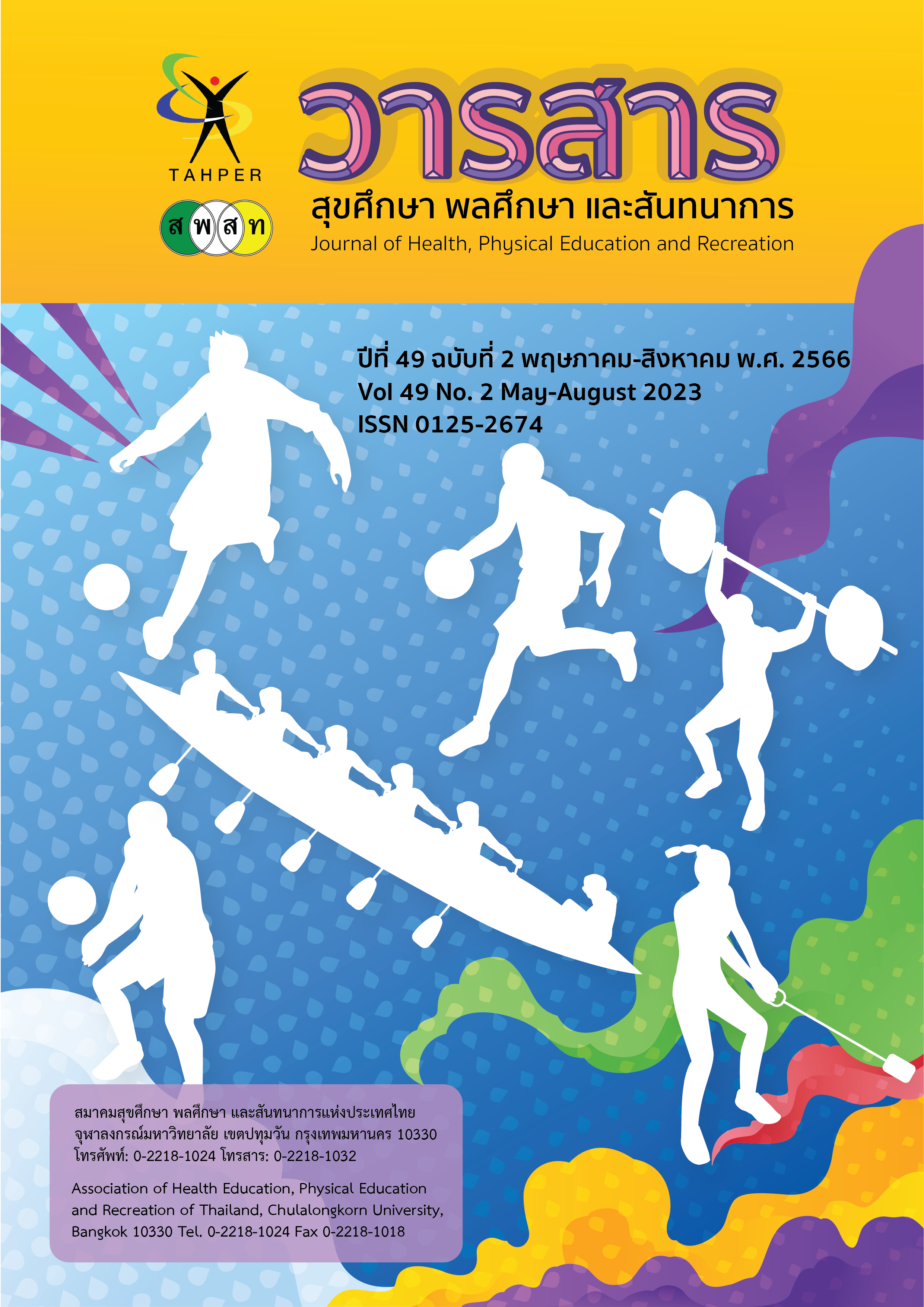The Effect of Napping on Lactate Recovery
Main Article Content
Abstract
The purpose of this research was to study the effects of napping on lactate recovery. Subjects were 20 male football players aged 14 – 16 years old of Suankularb Wittayalai (Jiraprawat) Nakhon Sawan school, Nakhon Sawan province. The subjects were tested Bruce Test protocol. In testing, the subjects must be tested with maximum effort until exhaustion and heart rate of not less than 85% of maximum heart rate (MHR). Immediately testing be completed, blood test at fingertip for measure lactate by Lactate plus testing. They were divided into 2 groups with match pair design by maximum lactate (Max lactate) and Maximal oxygen consumption (VO2 max) no significant. The napping group (n = 10) recovery by took a nap for 30 minutes while the no-napping group (n = 10) recovery by took a sit for 30 minutes. Variables studied was Lactate recovery by blood test after recovery 30 minutes. Data was analyzed by mean, standard deviation and ANOVA repeated analysis. Significant level was set at .05.
Findings was the napping group (3.06 mmol-1 ±.613) have lactate recovery faster than the no-napping group (4.02 mmol-1 ±.421) Significant difference at .05. The result showed napping effected on lactate recovery by causing the blood lactate decrease faster. This is the key factors in recovery from fatigue because when the athletes have the performance about faster recovery upon to the athletes have be ready faster for the next competition and affected for the performance about capacity fitness of the athletes.
Article Details

This work is licensed under a Creative Commons Attribution-NonCommercial-NoDerivatives 4.0 International License.
Critical thinking in journals is the right of the author. The Association of Health Education, Physical Education and Recreation of Thailand is not always required, to create diversity in ideas and creativity.
ความคิด ข้อวิพากษ์ในวารสารเป้นสิทธิของผู้เขียน สมาคมสุขศึกษา พลศึกษา และสันทนาการแห่งประเทศไทยไม่จำเป็นต้องเห็นชอบด้วยเสมอไป เพื่อให้เกิดความหลากหลายในความคิดและความสร้างสรรค์
References
ธนสิริ โชคทวีพาณิชย์. (2565). ผลของการนอนหลับระยะสั้นในช่วงเวลากลางวันที่มีต่อการฝึกเพื่อเพิ่มความสามารถในเชิงแอโรบิก. วารสารสุขศึกษา พลศึกษา และสันทนาการ, ปีที่ 48 (1), หน้า: 226-237.
สุชาติ โสมประยูร. (2523). สุขวิทยา (พิมพ์ครั้งที่5). กรุงเทพฯ: จุฬาลงกรณ์มหาวิทยาลัย.
สุดประนอม สมันตเวคิน. (2546). บทบาทของพยาบาลเพื่อส่งเสริมการนอนในผู้ป่วยวิกฤติ. วารสารสภากาชาดไทย, 21(1), 50-57.
Anning, J. H. (2012). Aerobic power. NSCA’s Guide to Tests and Assessments, edited by Miller, T. United State: Human Kinetic.
Harbili, S. (2015). The effect of different recovery duration on repeated anaerobic performance in elite cyclists. Journal of Human Kinetics, 49, 171-178.
Kenney, W. L., Wilmore, J. H. and Costill, D. L. (2012). Physiology of sport and exercise. (5th ed). IL: Human Kinetics.
McArdle, W.D., Katch, I. F. and Katch, L. V. (2016). Essentials of Exercise Physiology. (5th ed). Philadelphia: Wolters Kluwer.
Mednick, C. S. and Ehrman, M. (2006). Take a Nap! Change Your Life. New York: Workman Publishing Company.
Naylor, E., Aillon, D. V., Barrett, B. S., Wilson, G. S., Johnson, D. A., Johnson, D. A., Harmon H. P., Gabbert. S. and Petillo. P. A. (2012). Lactate as a biomarker for sleep. SLEEP, 35(9): 1209-1222.
Tietzel, A. J. and Lack, L.C. (2002). The recuperative value of brief and ultra – brief naps on alertness and cognitive performance. Jounal of Sleep Research, 11(3), 213-218.
Romdhani, M., Dergaa, I., Moussa-Chamari, I., Souissi, N., Chaabouni, Y., Mahdouani, K., Abene, O., Driss, T., Chamari, K. and Hammouda, O. (2021). The effect of post-lunch napping on mood, reaction time, and antioxidant defense during repeated sprint exercise. Biology of Sport, 38(4), 629-638.
Waterhouse, J., Atkinson, G., Edwards, B. and Reilly, T. (2007.) The role of a short post-lunch nap in improving cognitive, motor, and sprint performance in participants with partial sleep deprivation. Journal of Sports Sciences, 25(14), 1557–1566.


